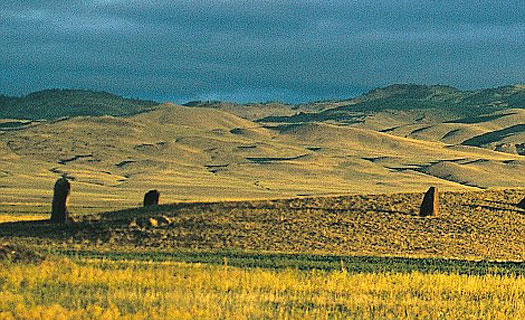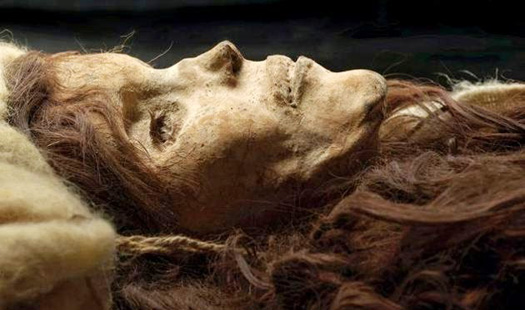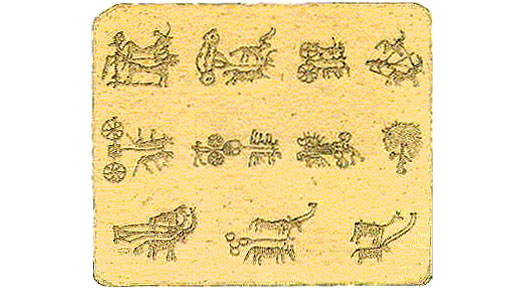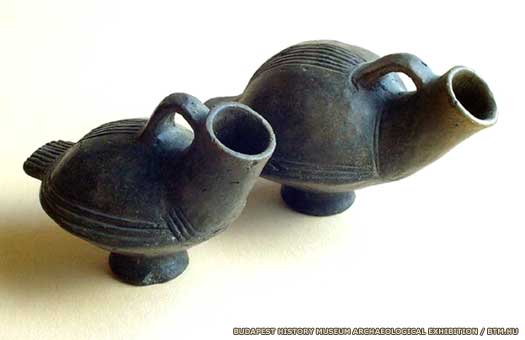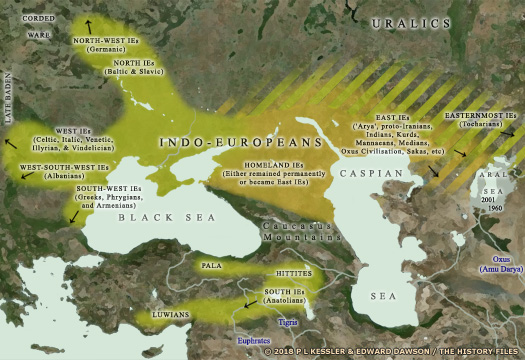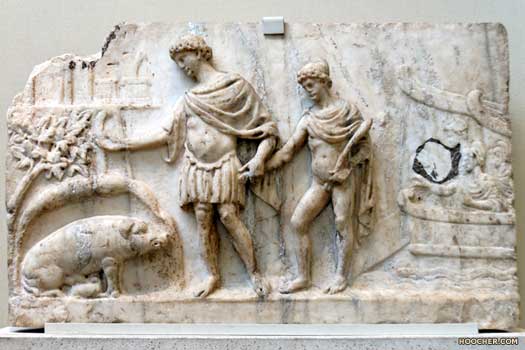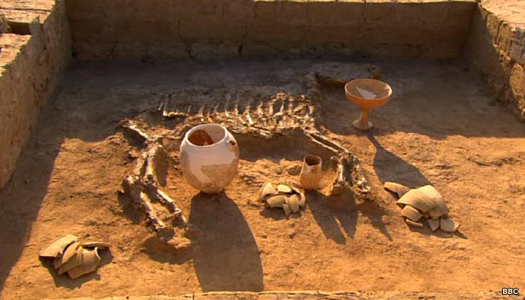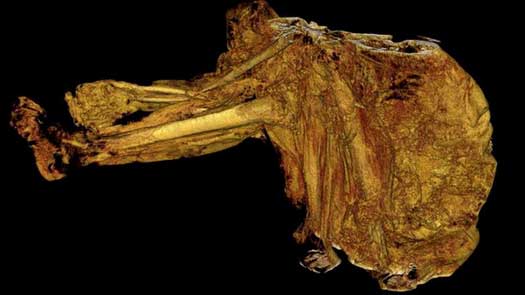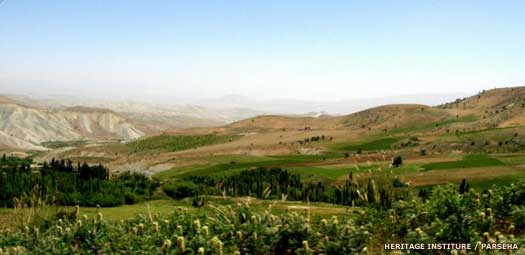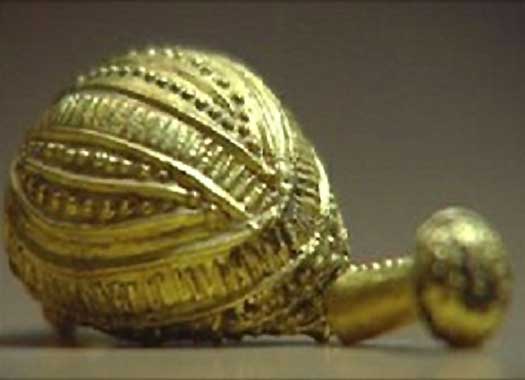
| INDO-EUROPEANS Scholars first noticed similarities between Sanskrit and Latin and Greek in the sixteenth century, as Europeans came into contact with India. But it was the British Asiatic Society in eighteenth century India under Sir William Jones that compared words across the three languages and found remarkable similarities. From this it was deduced that a common 'Proto-Indo-European' (PIE) root lay at the heart of all three languages and their peoples. This linked them back to an ancestral homeland that was probably located in the sweeping expanse of the steppes of Central Asia, to the north of the Black Sea and Caspian Sea. Scholars disagree about the precise location of this homeland even today, with a variety of others being proposed that include Anatolia and post-glacial Europe itself. Even so, the aforementioned steppes are still the favoured location, providing as they did a home to many later, similar groups of nomads such as the Huns and Turks.
How these people got there is unknown, but India was one of the first places to be colonised by early humans after they left Africa around 90-70,000 years ago (see the Hominid Chronology feature). Some of these people stayed where they were and others continued to follow the coastline to populate China and South East Asia. It seems likely that, after migrating inland, others further migrated northwards and in time formed communities around the steppes. Whether these communities existed in an unbroken line down to their developing into proto-Indo-Europeans can never be known. But however they developed, the proto-Indo-Europeans were in existence by the sixth millennium BC, in a homeland that seems to have been located somewhere between the Caucuses Mountains between the Black Sea and the Caspian Sea, and the northern shores of those same seas. Their subsequent migration is a hugely complex and contentious subject.
Whatever unknown level of unity these early Indo-Europeans may have had, they began to divide in the third millennium BC. Various groups migrated out of Central Asia from then onwards, pushed westwards and southwards by a combination of climate change, population movements, and perhaps pressure from other peoples further east. Their once-single language gradually altered into various dialects that can be divided into twelve branches, ten of which contain surviving languages. Very briefly, these are the Anatolians (the Hittites, Luwians, Lydians, and Pala), the Balts (such as the Latvians, Lithuanians, and Old Prussians on the eastern Baltic Sea coast), Celts (who once dominated Central and Western Europe), the Germanic peoples (who originate from Old Norse and Saxon peoples), the Greeks (most notably the Mycenaeans and Athenians), the Illyrians (of the northern and eastern Adriatic coast, surviving in Albania and with a level of heritage in southern Italy), the Indians (the disputed Indo-Aryan peoples as opposed to the pre-existing Dravidic groups who were generally pushed southwards), the Iranians (in the form of the Alani, Mannaeans, Medians, Persians, Scythians, and others), the Latins (embodied by the Romans), the Slavs (who emerged to dominate Eastern Europe by the medieval period), the Thracians (of northern Greece and the Balkans which also includes Armenians), and finally the Tocharians (in north-western China, who were closely related to the Anatolian, Celtic, and Latin branches).
Indo-Europeans account for some of the world's most notable ancient languages, including Greek, Latin, Pali, Persian, and Sanskrit. Many of the most important modern languages in the world are Indo-European, such as Bengali, English, French, German, Hindi, Russian, and Spanish. More than half of the world's population speak one or more of these languages, either as a mother tongue or a business language.
Recent genetic testing of living peoples, and ancient remains, are pointing in a slightly different direction from the standing Caucasian Mountains origin for Indo-Europeans. Males carry and transmit via their Y chromosome the history of male migration, critical for tracing the movements of warrior societies. Indo-European Y chromosomes carry two primary 'flavours', called R1a and R1b by geneticists. R1a is found strongly in Slavs, Balts, and Indo-Iranians, and is mixed with R1b in Germanic-speaking peoples. The geographic distribution in ancient times for R1a is European Russia just west of the Ural Mountains. R1b is found among other Indo-Europeans, being prominent among ancient Celts, Italics and similar (although it's important to note that not all R1b are Indo-Europeans). Geographic distribution appears to have begun with early cattle herders in south-eastern Turkey and northern Iraq, some of whom moved into the pasturage on the open steppes of Asia to the east of the Caspian Sea. What we have is an origin in the Russian forest and forest-steppe for half the Indo-Europeans (those linguistically matching the satem (East) branch of Indo-European languages, and occupying half the territory previously assigned to Uralics), and an open steppe origin for all other Indo-Europeans (matching the centum (West) branch of Indo-European languages). This threatens to invalidate the previously dominant theory of a Caucasian Mountains homeland for the Indo-Europeans, instead moving them farther north and east. It remains to be seen whether this DNA-based theory will supersede the established linguistics theory.
(Information by Peter Kessler and Edward Dawson, with additional information by Jo Amdahl, from The Horse, the Wheel, and Language: How Bronze-Age Riders from the Eurasian Steppes Shaped the Modern World, David W Anthony, from A Genetic Signal of Central European Celtic Ancestry, David K Faux, from the BBC Radio 3 programme with Bettany Hughes, Tracking the Aryans, 2011, and from External Links: Massive migration from the steppe was a source for Indo-European languages in Europe (Nature.com), and Peering at the Tocharians through Language, and Indo-European Chronology - Countries and Peoples, and Indo-European Etymological Dictionary, J Pokorny.)
Akkadian Empire :
Sargon created an Akkadian empire which truly unified Sumer and Akkad administratively for the first time ever. However, there were problems, not least because each of the former independent city states inside the empire resented the imposition of outside control, and revolts were common.
(Additional information by Ras Feqade.)
c.6000 BC :
It is approximately around this time that separation occurs between archaic pre-proto-Indo-European and its parent Nostratic tongue. When speculating about the reason for this, isolation in a mountainous region has to be a key factor. This event would be prior to the 'Kurgan Hypothesis' homeland, the dominant theory to explain the migrations of Indo-Europeans and the early cultures that they form.
However, results in 2015 from DNA tests on human remains from two burials in the Caucuses - one 13,000 years ago and the other 10,000 years ago - suggests that the separation could be far longer and older than this, perhaps as much as 25,000 years. Separated by the Glacial Maximum, they could have been cut off from outside DNA contact until as recently as 3,000 BC. The Yamnaya horizon which covers Indo-European expansion reveals the research results in more detail.
Professor Gennady Zdanovich has recently (2010) made fresh discoveries on the modern Kazakhstan steppe of Bronze Age 'spiral' cities which exhibit many signs of having been built and used by Indo-Europeans, having been built around 2000 BC c.5800 - 5000 BC :
Folk migrations by pioneer Near Eastern farmers reach the lower Danube valley and the edge of the Pontic-Caspian steppe by about 5800 BC. After several centuries of resistance and low-scale cultural influence from the farmers - principally members of the Bug-Dniester culture - their new herding economy is adopted by a few key forager groups on the River Dnieper. It then diffuses very rapidly across most of the Pontic-Caspian steppe as far east as the Volga and Ural rivers. This revolutionary event transforms the economy, rituals, and politics of the steppe-dwellers. A new set of dialects and words spreads across the steppes with the arrival of the new economic and ritual-political system - the ancestors of proto-Indo-European. Chiefs begin to emerge, along with religious leaders and ministers.
c.4000 BC :
By this period, if not from the very beginning, the newly-emergent proto-Indo-Europeans in Central Asia form an homogenous people who all speak the same general language. The Uralic-speaking foragers to their north borrow some of their words, probably through trade contacts. Their expansion sees the beginning of areal dialects (a common language that is spread over a division of areas and spaces with regional differences emerging). Through a study of these dialects and their progression some idea of movement can be built up. Perhaps first established as part of the Suvorovo culture of this period, the Anatolian dialect moves south (perhaps even earlier than this date - 4400 BC seems a fair approximation), while most of the others appear to expand north into the Pontic-Caspian steppe.
Is the horse domesticated and the horse-drawn wagon adopted at this time? The Sumerian invention of the wheel seems to take place no later than 3500 BC and its use explodes across the ancient world, even reaching the comparatively isolated proto-Indo-Europeans within a century or so. This horse-drawn wagon/wheel culture forms the basis of the 'Kurgan Hypothesis' homeland period (the most popular theory surrounding Indo-European migration), with most Indo-Europeans in the steppe. Suddenly the vast steppe is open to them rather than their being limited to its edges so that they can return to semi-permanent dwellings in the fertile river valleys. Instead, domesticated animal herds can increase massively in size, populations can also expand, and the Neolithic family clan group now begins to break up as smaller kin groups become more mobile.
c.4000 - 3500 BC :
This is the early proto-Indo-European phase in the Indo-European homeland on the Pontic-Caspian steppe. It is during this phase - and probably towards the end of it - that the Tocharian branch begins to break away and migrate eastwards, following the Central Asian steppe towards Mongolia and western China. There they form the Afanasevo culture. The exact details are theoretical but, due to elements of the Tocharian language which preserve early elements of proto-Indo-European, it has been proposed that the Tocharian group is originally made up of western Indo-Europeans who are heavily influenced by their eastern experiences.
This example of the Tarim Basin mummies (descendants of the Tocharian migrants) had the usual distinctive European features, along with a full head of red hair which had been braided into pony tails, and items of woven material which match similar Celtic items c.3500 - 3000 BC :
Linguists
have pinpointed this period for the development of a pastoral
code amongst the early Indo-Europeans who are busy driving their
herds of cattle across the vast plains of the steppes. The theory
behind such a code of behaviour is that, one group of people happen
to see a dot on the horizon that turns out to be another approaching
group, then they have two choices for how they will react: attempt
to destroy them or deal with them peaceably. The pastoralists
go with the latter - presume friendship until the evidence disproves
it - and this concept generates the word *ghos-ti-, meaning 'stranger,
guest', but also 'host'. Both 'guest' and 'host' are direct descendants
of this word. The same concept is passed down to the Classical
Greek world. c.3500 BC :
The Anatolian branch of the Indo-European language has already separated entirely from the other groups, first becoming pre-Anatolian, and then evolving into proto-Anatolian. It retains many archaic features which are later lost from the other branches of the Indo-European language. However, it forms the ancestor of the Hittite language, plus Luwian (with many sub-branches - see c.1600 BC, below, for details of these), Lydian, and Palaic, all of which have been part of the Anatolian movement from the Indo-European homeland, heading south through the mountains of the Caucuses, eventually to reach the highlands of Anatolia. From there, the Hittites manage to form an empire that encompasses most of Anatolia, although they are later arrivals and it takes them longer to settle than it does the Luwian-speakers. Pala speakers are later overrun by the non-Indo-European Kaskans and their dialect dies out following absorption by the Phrygians.
c.3500 - 3300 BC :
Other groups have already begun to migrate westwards, and also southwards away from the Anatolian and Tocharian branches. All of these westwards groups often use four-wheeled wagons to transport their people, and possess wagon/wheel vocabulary that is wholly original to themselves, but which is not shared by the Anatolian group and is only partially shared by the Tocharian group, demonstrating an arrival of the wheel some time around the point at which the Tocharians had been beginning to lose touch with their kinsfolk.
The process of migration begins a fragmentation that sees these late proto-Indo-Europeans enter large swathes of Europe, the Near East, and South Asia. One of the first groups to arrive in Europe forms the Corded Ware culture (from about 2900 BC) which initially (and in part) settles around the Baltic coast to become the later Belarussians, Latvians, Lithuanians, Prussians. The Slavic group is closely related to the Balts but appears to separate from it before the latter reaches the Baltic coastline.
The Yamnaya Horizon theory saw many semi-nomadic pastoral tribes migrate huge distances over many generations, helped by their use of four-wheeled wagons and chariots, and the petroglyphs shown here (from northern Mesopotamia) form one of history's earliest recordings of these chariots According to David Anthony, the Yamnaya Horizon explodes across the Pontic-Caspian steppe around 3300 BC, this being the primary vector through which proto-Indo-Europeans spread westwards. The various interrelated cultural expressions that form the basis of this 'horizon' are created by early proto-Indo-Europeans who belong to semi-nomadic, pastoral tribes which can, more or less, understand each other. Beginning their migration, these people reach the Carpathian Mountains and the River Danube near modern Budapest, where this folk migration appears to halt.
Nature.com (2015) supports the 'Yamnaya Horizon' theory. By around 4000-3000 BC, farmers throughout much of Europe have more hunter-gatherer (forager) ancestry than their predecessors (showing a gradual blending of earlier hunter-gatherers and the farmers who had arrived between about 6000-5000 BC). In Russia, the Yamnaya steppe herders of this time are descended not only from the preceding Pontic-Caspian hunter-gatherers, but also from a population of 'Near Eastern' ancestry. Neolithic farmers had expanded around the western coast of the Black Sea to interact with the hunter-gatherers in the sixth millennium BC, and it seems that, eventually, the two groups had intermingled, producing a population that was mixed with a greater degree of farmers than in Western Europe.
c.3300 BC :
Very recently, in far south-eastern Europe, in the North Caucasus Mountains, spectacularly ostentatious chiefs had suddenly appeared amongst what had previously been very ordinary small-scale farmers. They display gold-covered clothing, gold and silver staffs, and great quantities of bronze weapons obtained from the newly formed cities of Middle Uruk Mesopotamia, through Anatolian middlemen. This is probably the first true contact between southern urban civilisations and the people of the steppe margins, taking place about 3700-3500 BC, and it forms the basis of the creation of Maikop culture.
Something less obvious to many is that cannabis may be travelling in the opposite direction to the gold and silver that is coming from the south - this time travelling from the Pontic-Caspian steppes to Mesopotamia and the early city states of Sumer. Greek kdnnabis and proto-Germanic *baniptx seem to be related to the Sumerian kuriibu. Sumerian dies out as a widely spoken language after around 2000 BC, so the connection must be a very ancient one. The international trade of the Late Uruk period (circa 3300-3100 BC) provides a suitable context for this trade.
The link between the early, proto-Indo-European form of the word cannabis (and therefore its probable Sumerian origin of kuriibu) to the proto-Germanic form requires a few steps. In the late Bronze Age, proto-Germanic groups are pretty isolated in southern Scandinavia and along the southern shore of the Baltic Sea, but are theorised to be in contact with the proto-Celts (and possibly even dominated by them). In support of this is the realisation that 'cannabis' would need to pass through Celtic to reach its Germanic form: the initial 'k' would be a 'kw' in Q-Celtic (of the First Wave), transformed to a 'p' in P-Celtic (of the Second Wave), and then transformed into a 'b' in Belgic (northern Celtic), and finally adopted into Germanic. This appears to fit in with the idea that Belgic Celts dominate northern Europe prior to the rise of the Germanic tribes around the fifth century BC.
Bird vases of the late second millennium Urnfield culture were objects that were closely related to the Urnfield belief system, and it may not be accidental that this vase was found next to a pot containing bird eggs in the cemetery of Békásmegyer, as the two objects together may emphasise the pots' symbolism of life and fertility c.3300 - 2600 BC :
Possibly offshoots of the Yamnaya cultural horizon which had formed after westwards migration had halted at the River Danube around Budapest, groups of Indo-Europeans now first begin to arrive in Greece (or a little later based on revised theories - passing through and probably interacting with the general mass of Indo-European tribes of the northern Balkans). They blend with the indigenous populations to later form Mycenaean, Minoan, Cypriot and (southern) Italian cultures. Similar groups also begin to arrive in north-western Europe, settling amongst earlier populations of Neolithic farmers and Palaeolithic hunters.
Further to the 'Yamnaya Horizon' theory (see previous entry, above), David Anthony adds that the split between the Italic and closely-allied Celtic language groups appears to occur between 3100 and 2600 BC. Then Bell Beaker decorated cup styles, domestic pot types, and grave and dagger types from the middle Danube are adopted around 2600 BC in Moravia and southern Germany, possibly as a result of trade rather than immediate migration. However, this material network could be the bridge through which pre-Celtic dialects spread into Germany. The southernmost areas of this, Austria, and Bavaria, seemingly become the location in which proto-Celtic originally develops - in other words the language's homeland.
According to Ellis (1998), The large number of Celtic place-names still surviving in Switzerland and south-western Germany are therefore an indication that when the Celtic peoples appear in the historical record they are already well-settled in this area. He also echoes Hubert's views that the survival to this day of so many Celtic names for important geographical features (such as the rivers Rhine and Danube) in what are now German-speaking regions points to the names being of indigenous form and of long usage.
c.3000 BC :
Whether David Anthony's proposed timescale is accepted or not, a date of around 3000 BC is still used as the probable point at which the remaining Indo-Europeans (excepting the Anatolian branch) begin to separate into definite proto languages which are not intelligible to each other. A western group will evolve into or subsume Celtic, Italic, Venetic, Illyrian, Ligurian, Vindelician/Liburnian and Raetic branches. Early in this western group's expansion, one tribe apparently makes the aforementioned U-turn and heads east (which is easy enough to do when you are a steppe nomad!) to evolve into the Tocharian branch of Indo-Europeans (see 2200 BC, below).
A north-western branch begins the Germanic ethnic group (which apparently splits away from the western edge of late proto-Indo-European dialects around 3300 BC - see feature link, right). A northern branch evolves into what will become the aforementioned Baltic peoples (principally Latvians, Lithuanians and Old Prussians) and also the Slavic peoples (with division between the two occurring around 2500 BC). Proto-Greeks form a south-western branch that emerges as the Mycenaeans (around 2500 BC), probably along with Thracians, Dacians, and Phrygians, all of whom seem to be related to the Armenians.
An eastern branch - or perhaps a branch that stays in the steppe homeland for another millennium or so and which therefore becomes an eastern branch by default because the rest have headed off west - apparently calling themselves Arya or something similar form the ancestors of a good deal of India's modern population (except for the southernmost parts - see 2200 BC, below), plus Kurds, Persians, Mannaeans, Medians, and related peoples (see 1200 BC, below), possibly also including the Sakas. All of these groups are classed as Indo-Iranians and their sub-divisions.
By around 3000 BC the Indo-Europeans had begun their mass migration away from the Pontic-Caspian steppe, with the bulk of them heading westwards towards the heartland of Europe c.2500 BC :
Nature.com (2015) has this as the approximate time at which the Yamnaya steppe people come into contact with Western Europe's population of farmers and increasingly farming-orientated hunter-gatherers. The Late Neolithic Corded Ware culture is one of the first results of this arrival (having already made its earliest appearance around 2900 BC). Corded Ware people from Germany trace around seventy-five per cent of their ancestry to the Yamnaya, documenting a massive migration into the heartland of Europe from its eastern periphery. This steppe ancestry persists in all sampled Central Europeans until at least 1000 BC, and is ubiquitous in present-day Europeans.
It would seem to be around this time that a process begins in which the so-called West Indo-European tribes, most of whom speak dialects that are intelligible to the other tribes, start a long process of fracturing and dividing. There is also an unrelated tribe which is not as closely related to this group which follows a path along the northern reaches of Europe at some unknown point in time, and which becomes the Germanic-speaking people.
The West Indo-European speakers appear to form a divide into two groupings due to location and contacts. The northern group becomes isolated from direct contact with the Mediterranean civilisations and these people become the proto-Celts of the Urnfield culture.
The southern group of West Indo-Europeans appear to migrate westwards and southwards into the western Balkans and Italian piedmont, and through Illyria and northern Italy. Due to terrain, they divide further into semi-isolated tribes, becoming more civilised in habits and technologies due to contact with southern Greeks and Etruscans. Those in the Balkans in part cross by sea into the Italian peninsula, and settle mostly along the south-eastern coast. Those groups that have filtered down from the north Italian piedmont occupy swathes of central Italy, with two tribes, Latins and Faliscans, crossing over the Apennines to the west coast. Because of their semi-isolation to the west of Italy their language does not undergo the 'qu/kw' to 'p' shift that occurs across most of the West Indo-European dialects.
This second century AD relief in Rome depicts Aeneas landing in Latium, although such a migration myth was a much later addition to the history of the Latins than their true migration as Indo-Europeans c.2350 -2300 BC :
The Gutians, possible Indo-European tribes in the Zagros Mountains, are first mentioned, and go on to dominate southern Mesopotamia for a century. In the same period, Indo-European tribes in the form of the Luwian peoples settle across southern Anatolia. It seems more than coincidental that 'barbarians from the north' are causing problems in cities within Syria such as Ebla at the same time. Without any written evidence to support such a claim, it does seem likely that one of these groups is responsible for probing expeditions farther south.
c.2200 - 2000 BC :
An indigenous Bronze Age culture emerges in Central Asia between modern Turkmenistan and down towards the Oxus (otherwise known as the Amu Darya), the somewhat nebulous region called Transoxiana. It is known as the Bactria-Margiana Archaeological Complex, or Oxus Civilisation (centred on the later provinces of Bactria and Margiana). Indo-European tribes who have not taken part in the exodus to the west or south soon integrate themselves into it. In fact, these Indo-Europeans seem to have remained in the old homeland to the north of the Black Sea and Caspian Sea longer than other Indo-European groups, at least partially generating the Sintashta culture and Andronovo horizon to the east.
It may also be this Oxus culture, or a neighbouring Indo-European group which feeds off its progressive nature, which forms the 'spiral cities' of the Kazakhstan steppe (see the first photo on the page, above). Items that have so far been recovered from recent exploration in this region include make-up equipment, a chariot, and numerous pieces of pottery. The artefacts are daubed in swastikas (symbols of the sun and of eternal life). Evidence of ritual horse burials are also found, which ties in with ancient Indo-Aryan texts that describe the animals being sliced up and buried with their masters.
Given the fact that they appear in the historical record around the same time, the Andronovo people and other Indo-Europeans who integrate into the Oxus may be related to the Anatolian branch of Indo-European languages which had begun to divide from the other branches around 3500 BC (see above). Alternatively, they may be related to the comparatively late migration of the Indo-Iranians and Indo-Aryans who become the Alani, Mannaeans, Medians, Mitanni, Persians, Scythians, and Indians, and possibly also the Sakas. The latter option seems the most likely one.
This king's tomb in the Indo-European settlement in the Karakum (modern Turkmenistan) contains a valuable horse to accompany him into the afterlife 2000 - 1700 BC :
Climate change from around 2000 BC onwards greatly affects this civilisation, denuding it of water as the rains decline. The people are forced to migrate away, abandoning many of their cities. Indo-Iranian groups become dominant here, and over time some of their descendants enter Iran to found states such as that of the Mannaeans, the Median empire, and early Persia. Some go even farther even earlier to form the Mitanni empire. Others cross the rivers of modern Afghanistan and the Hindu Kush mountains and enter India between 1700-1500 BC. They eventually form their own kingdoms there such as Magadh, plus Kaling, and the Kaurava state.
c.2000 BC :
DNA analysis in 2015 of three males from this period backs up the theory that Ireland is populated via waves of immigration. The males are from Rathlin Island and live very soon after metallurgy is introduced into Ireland. They show a different DNA pattern from earlier populations, with a third of their ancestry coming from the Pontic Steppe (now covering much of Ukraine and a large swathe of southern Russia), which links them directly to the Indo-Europeans. They show a close genetic affinity with the modern Irish, Scots, and Welsh, but not so close a connection with the English, who have been diluted by the Anglo-Saxon admixture.
While these arrivals are not necessarily Celts as such, they can seemingly be counted as proto-Celts, springing as they do from the same stock that settles in Central Europe and later forms the basis of Celtic culture. Indo-Europeans are nomadic, moving quickly in four-wheeled carts or chariots. While many of them may indeed be expanding and migrating slowly, generation by generation, it wouldn't take much for a small group (less than 100,000) to leave the others behind. When they reach water they may learn to make boats from the Mediterranean types already occupying the coastal areas. This rapid movement can be compared favourably with how quickly the later Cimbri travel from Jutland to Italy, and the journey could be completed in well under a decade of travel.
The Cashel Man bog body of Ireland has been compressed by four thousand years of peat build-up, but his outstretched hand can still be made out above his legs (to the left of the picture) c.1600 BC :
Following the beginnings of their migration into Anatolia of around 3500 BC and settlement around 2300 BC onwards (see above), the Luwian peoples now begin to emerge into history divided into two groups; the Arzawans to the west and the Kizzuwatnans in the east. The poorly-attested peoples of Ishuwa, Karkissa, and Lukka are probably also Indo-Europeans. The Mycenaeans also emerge into history at this time, having been located in Greece (and later Cyprus) since at least 2400-2200 BC. Around the same time, an Indo-Aryan group, perhaps part of the migration towards India, arrives in northern Mesopotamia to rule the Hurrians as a warrior class called the Mitanni.
c.1450 BC :
The Indo-European Phrygians begin to infiltrate from the Balkans into Bithynia in western Anatolia. Within about two and-a-half centuries they create their own kingdom in western Anatolia. Various other Indo-European peoples also populate the area, such as the Thracians.
c.1200 - 900 BC :
Social collapse and a dark age engulf the Near East. During this period, various tribal groups found new cities and kingdoms, among them the Medians and Persians on the Iranian Plateau. Indo-European groups in Europe filter into Italy, where they form the two main groups of Italic peoples, the Oscan-Umbrians (including the Umbri) and Latino-Faliscans (including the Latins).
In Greece, Mycenaean power is gradually eroded by the invading Dorians from the north, with domination coming by 1140 BC. The surviving Ionic-speaking Mycenaeans gather and flourish in Athens, or in conquered Levantine territories which probably include Phillistia, or in new colonies founded well away from the Dorians, such as Epirus.
One of the earliest proto-Celtic cultures has already started to appear in Central Europe, this being the Late Bronze Age Urnfield culture. Proto-Celtic groups also migrate outwards, some ending up in Britain, where they eventually push back or integrate with the indigenous population and settle in the fertile south and east. They also later infiltrate into Ireland (although see c.2000 BC, above).
The Zagros Mountain range provided the Medes with their home, but it was also the Assyrian gateway into Iran, one that was used in later attacks on the Indo-European Persians and Medes 1000s BC? :
Norse legend mentions gods who are described as members of two groups: the Aesir and the Vanir. This latter is very suggestive of early contact between Germanics in Scandinavia and the seagoing Veneti living along the Gulf of Gdansk and the Vistula. However, the exact origins of the Vanir and the war between them and the Aesir are open to intense speculation.
There is strong evidence among the various peoples of the Indo-European diaspora that two distinct groups of deities are honoured. This appears to be best preserved among the Hindus, who talk about them as Devas (suras) and Asuras (not-suras). Some cultures later preserve worship of both; others choose one or the other and indicate some sort of conflict between them. The Aesir appear to be Asuras. Two Hindu Asuras, known as Thor and Ermin among Germanics, appear in the Norse pantheon.
One thing that can be said with some certainly is that the Vanir do not seem to be Suras/Devas. That leaves the possibility that the Aesir/Vanir war is a legendary account of a human war, but whether between Germanics against Celts, or against the Kvens whom they are steadily displacing in southern Scandinavia is unclear, A war involving Germanics is a certainty; in fact, two wars. It is already known that the Indo-European tribes who have evolved into Germanics have entered Scandinavia and have displaced someone, almost certainly Finno-Ugric speakers. There's also evidence that Celts enter Jutland. So which of these interactions with the Germans is the cause of war? That's a very good question. Both have names that could evolve over time into 'Vanir'. 'Veneti' could lose its 't' due to softening, while the 'k' of Kven would easily soften to 'ch', leaving 'ven'. So who are the wanes/vanir? Anything further would be speculation.
8th century BC :
An Indo-European people known as the Armenians first enter Anatolia from northern Mesopotamia, migrating into the region around Lake Van which will be their homeland for the next 2300 years. In Europe, while the Indo-European Celts are beginning to expand from their traditional territory in southern Germany, the early Germanic peoples still seem to be occupying a homeland in southern Sweden and the Jutland peninsula. Around the shores of the Black Sea, groups such as the Cimmerians, Scythians, and Thracians all appear to bear similarities in culture and perhaps even language, which allows them to act in various raids and battles as unified forces against the established city states of Anatolia and Mesopotamia.
Celtic gold and amber jewellery unearthed from a burial show that this group of Indo-Europeans had achieved very high levels of skill in their creations by the first millennium BC 6th century BC :
The Indo-European Bactrians are conquered by their cousins, the Persians. By this stage all of the various Indo-European branches have fully splintered, and have developed into groups that have their own individual histories and daughter languages. The proto-Indo-European language itself will have died out around 2500 BC, when its daughter languages began to appear, but its core language remains a part of all its descended forms, even today. A large proportion of the ancestral steppe homeland of the proto-Indo-Europeans is today within the borders of Kazakhstan.
Source :
https://www.historyfiles.co.uk/ |
